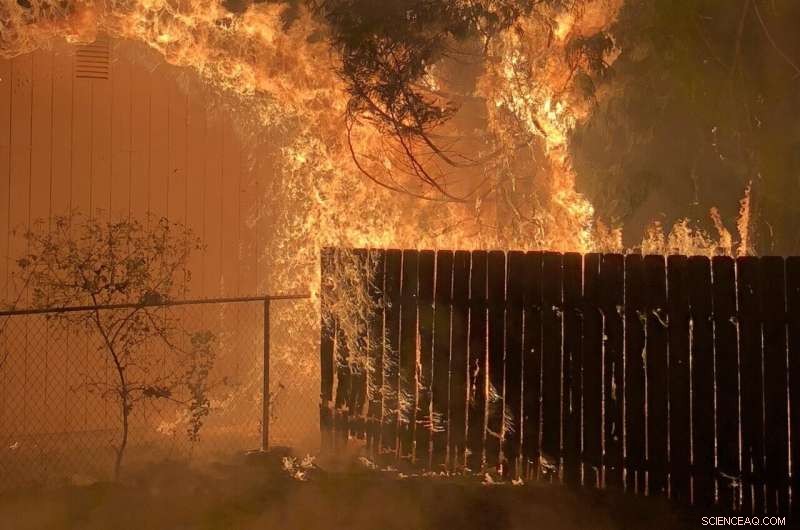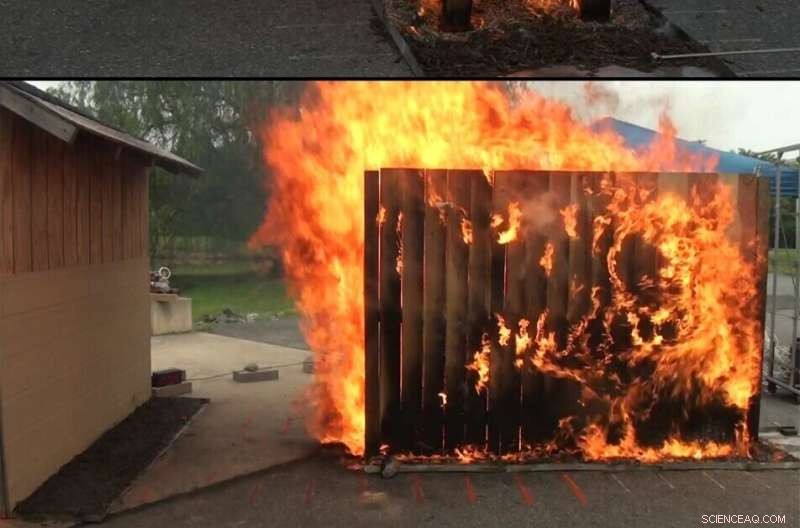
Las cercas y el mantillo son contribuyentes comunes a la propagación de incendios en las comunidades de interfaz urbano-forestal (WUI). Esta foto muestra las llamas que se extendieron desde una cerca en llamas hasta un edificio a unos 1,8 metros (6 pies) de distancia durante el Camp Fire de 2018. Crédito:CAL FIRE
Al construir cercas y ajardinar sus propiedades, los propietarios deben tener en cuenta la seguridad contra incendios, especialmente si viven en una región propensa a incendios forestales, según un nuevo estudio.
En casi 200 experimentos con incendios, los investigadores del Instituto Nacional de Estándares y Tecnología (NIST, por sus siglas en inglés) quemaron cercas residenciales y lechos de mantillo para examinar el papel que desempeñan en la propagación del fuego. Descubrieron que el riesgo de incendio era generalmente desproporcionadamente mayor cuando los objetos combustibles se quemaban juntos. Las llamas se precipitaron a lo largo del mantillo que recubría la base de las cercas, y los infiernos se tragaron rápidamente pares de cercas cuando se quemaron muy cerca unas de otras. Por el contrario, las cercas independientes libres de mantillo o escombros se quemaron a un ritmo mucho más lento. Con base en sus hallazgos, los autores del informe recomendaron que los propietarios de viviendas no coloquen dos cercas espalda con espalda, mantengan otras superficies combustibles separadas y tomen otras medidas importantes.
Los incendios forestales pueden propagarse rápidamente y potencialmente abrumar a las comunidades adyacentes a la naturaleza, la llamada interfaz urbano-forestal (WUI). Los estudios posteriores a los incendios forestales, incluido el estudio del NIST sobre el Camp Fire de 2018, han señalado las cercas y el mantillo como los culpables de la propagación del fuego.
"Las cercas que se incendian a menudo desaparecieron por completo. Si mirabas de cerca, podías ver que quedaban algunos clavos y tornillos. Los que vimos parcialmente quemados quedaron en pie porque alguien los defendió", dijo el coautor del informe, Alexander Maranghides, quien lidera el estudio Camp Fire del NIST. "Estas cosas no se apagan solas".
Las cercas y el mantillo pueden actuar como puentes para que las llamas lleguen a los edificios y como plataformas de lanzamiento para que las brasas en el aire enciendan fuegos lejanos, pero los códigos contra incendios en los EE. UU. no abordan cómo deben instalarse y mantenerse, y existe poca orientación para ayudar a los propietarios de viviendas.
Para ayudar a construir una base técnica para el desarrollo de pautas en el futuro, los autores del nuevo informe buscaron estudiar los incendios de cercas y mantillo en condiciones más cercanas a la vida real que las que se han utilizado en estudios anteriores.
El equipo de investigación quemó cercas, lechos de mantillo y combinaciones de ambos al aire libre, encendiendo los materiales a varios metros a favor del viento desde una máquina de viento utilizada para simular condiciones reales de propagación de incendios. Sotavento del fuego, el equipo instaló un cobertizo o una cama de mantillo como objetivo.
A través de 187 experimentos, quemaron combustibles solos y en combinación, incluidas cercas de varios diseños comunes hechos de madera, vinilo o compuestos de madera y plástico y lechos de mantillo compuestos de madera dura triturada, pepitas de corteza de pino, paja de pino o caucho.
Los investigadores capturaron imágenes de las llamas para medir la velocidad y el patrón de propagación de las llamas y registrar con qué frecuencia las brasas encendían el cobertizo objetivo. They also conducted research in the lab to measure how quickly samples of fence raw materials released heat.
Taking all the data together, the authors categorized the relative fire threat level for the various test conditions.
"In the highest hazard category, the fences and mulch are going to carry the fire along toward your house in a matter of a few minutes, not hours," said NIST physicist Kathryn Butler, co-lead author of the report.

An experiment wherein NIST researchers burned two privacy fences separated by 46 centimeters (18 inches), sitting on top of mulch, demonstrates the danger of placing fences back to back. In less than four minutes after ignition, the fences were entirely engulfed in flames, which extended several feet beyond the fences. Crédito:NIST
The most dangerous fires observed were those that had multiple sources of fuel burning at the same time. In the tests where mulch lined the bottom of a fence, fire tended to swiftly advance across the beds of fine combustibles, which served as rich sources of embers and allowed flames to quickly ignite the fence along its entire length.
The researchers learned that the fires could get much worse as well.
When two fences made of combustible materials were placed back to back—mimicking the scenario where two neighbors each put up a fence along their property lines—the most intense flames of the entire project erupted. After the fire was established, long-reaching flames quickly shot up, completely engulfing fence panels 2.4 meters (8 feet) long and 1.8 meters (6 feet) tall in as little as four minutes. Embers sparked fires on the target in almost every one of these tests.
"It's very well known that when you confine a fire on the sides, it's bad news. Keeping those hot gases between the fences with surfaces radiating intense heat to each other leads to explosive fire behavior," Butler said.
When fence panels burned alone, it was a different story. Flames slowly chewed away at the fences and did not spread very far during these experiments, with some progressing less than a meter (3.3 feet) in an hour. Although these fires burning slowly on a sole fuel source were less hazardous and more manageable, high winds that may accompany a wildfire could blow debris toward the fence, adding fuel to the fire.
Butler, NIST mechanical engineer Erik Johnsson and the rest of the authors crafted seven recommendations for homeowners living in WUI zones based on their analysis. The first recommendation is to avoid doubling up on fences completely, as the study found that fences as far apart as 91 centimeters (3 feet) still produced large flames. The second says that combustible fences should be placed where they will not interfere with exit routes.
Other recommendations advise keeping combustibles as far away from each other as possible, even between property lines, and clearing yards—and especially the space near or between fences—of debris, such as leaves or fallen branches.
The report also indicates that homeowners should replace combustible landscape features with those consisting of noncombustible material such as stone, steel or cement, when possible.
Because of the ever-present danger of embers during wildfires—even when there is a large distance between a structure and the fire—the researchers also urge homeowners to enhance their homes to resist ember ignition through a process called hardening. The detailed steps for hardening are described in a separate NIST report on mitigating wildfires.
The team members intend to keep pushing forward to cover new ground in wildfire research.
With additional experiments, they plan to offer additional insights on risk mitigation and eventually lay a groundwork for new guidance, standards and fire codes that could curb the real wildfire hazards that endanger life and property in the U.S.
The research was published as NIST Technical Note 2228 . Study shows wildfire does not damage barbed wire